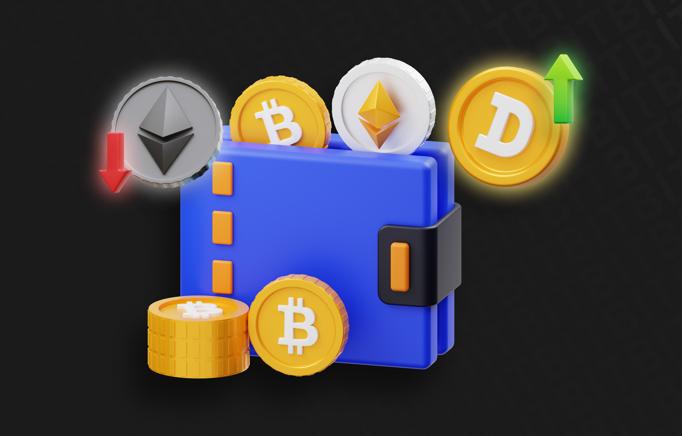Inflationary and Deflationary Currencies
العملات المشفرة للمحترفين
مقالات أخرى
Currencies are used as a means for exchange for goods and services, and over the centuries, prevalent monetary structures have evolved. Nations created & adopted fiat currencies which have values linked to other currencies, and the modern world of crypto is witnessing the rapid adoption of digital currencies which are taking the world by storm.
The value of a certain currency is impacted and shaped by specific factors, with some losing value over time and some gaining it. Inflationary currencies are those which witness a consistent rise in circulation over time, and that diminishes the value of the currency. The maximum supply of deflationary currencies is typically fixed and as long as demand is high, their value increases over time.
What is inflation & deflation to begin with?
Inflation and Deflation
Economies boom and deplete, and among the catalysts behind macroeconomic growth or despair are the occurrences of inflation and deflation. Inflation refers to the growth of the price of all goods and services in an economy in a specific period of time.
There are two main inflation causes:
1- Demand-pull: When demand exceeds past production capabilities, it induces a natural rise in prices to meet the higher demand. This can apply to specific sectors or the economy as a whole, depending on demand severity and omnipresence.
2- Cost-push: When production costs escalate, potentially due to supply chain disruptions or rising raw materials prices, and thus, the higher costs are transferred to the price of end-products and services.
On the other hand, deflation is when the all-round prices of goods and services in an economy decrease or in other words, deflate. Negative inflation or deflation is usually caused by:
1- Fall in demand: When demand for goods and services decline, it triggers a fall in their respective price-tags. This can be due to diminishing money supplies or weakening investor confidence.
2- Increase in supply: When supply of goods and services exceeds demand, perhaps due to lower production costs or technological advancements, the prices of offerings will naturally decrease to balance the disproportioned forces of supply & demand.
Inflationary Currencies
When the supply of something regularly increases, it can be hard for demand to keep up. Due to that simple law of economics, inflationary cryptocurrencies tend to lose their value over time as more of them are being injected into circulation. Typically, fiat currencies such as the Euro and some cryptocurrencies which don’t have a limited supply, like Dogecoin, can be regarded as inflationary currencies.
For example, the price for a cup of coffee in the United States was $0.25 in 1970, $0.75 in 1990 and $1.85 in 2022. As more USD is being printed and fed into circulation, the value of the currency depletes. In this example, the purchasing power of USD has weakened, meaning that $1 in 2022 buys a smaller basket/bundle of goods when compared to 1990.
Deflationary Currencies
It can be argued that the cryptocurrencies are inherently deflationary, even when they have an unlimited supply of interchangeable tokens. This is because they aren’t controlled by governments or institutions, and their scarcity and price are determined by algorithms.
The algorithms can involve the concept of burning crypto, which means destroying a number of coins. Therefore, there will be fewer coins in circulation and if demand remains intact or high, the prices of these crypto assets tend to increase, and so does their purchasing power.
Some cryptocurrencies are more deflationary than others, especially when supply is tighter or when their respective projects involve different deflationary techniques to achieve certain objectives. For example, Ethereum launched an update in August 2021 to make Ether deflationary amid rising network activity, and this initiative also involved the burning of ETH to cut supply. If market demand recovers from the lows of 2022, deflationary currencies can enjoy great surges in price.
The Economics of Inflationary and Deflationary Cryptocurrencies
Let’s break the economics down. Inflationary & deflationary currencies are affected by two major factors. The first would be supply. Inflationary cryptocurrencies are more readily-available and are characterized by higher supply than demand, while deflationary coins are typically limited in supply when compared to their demand.
The second economic factor which differentiates the two would be purchasing power. In most cases, the higher availability of inflationary currencies diminishes their purchasing power, and the limitedness of deflationary tokens bumps their purchasing power higher.
Mix & Match

All-in-all, it would be wise to mix & match between inflationary and deflationary cryptocurrencies. The former has immense use cases, while the latter may rise in value relative to scarcity and demand retention.
It’s a smart move to diversify your crypto wallet with more than one asset type, including stablecoins, governance tokens and payment coins, to safeguard your portfolio and capital.
Read our Guide to Building a Balanced Crypto Portfolioto learn more about the benefits of diversification and how it can leverage your probability of capital growth and longevity.


